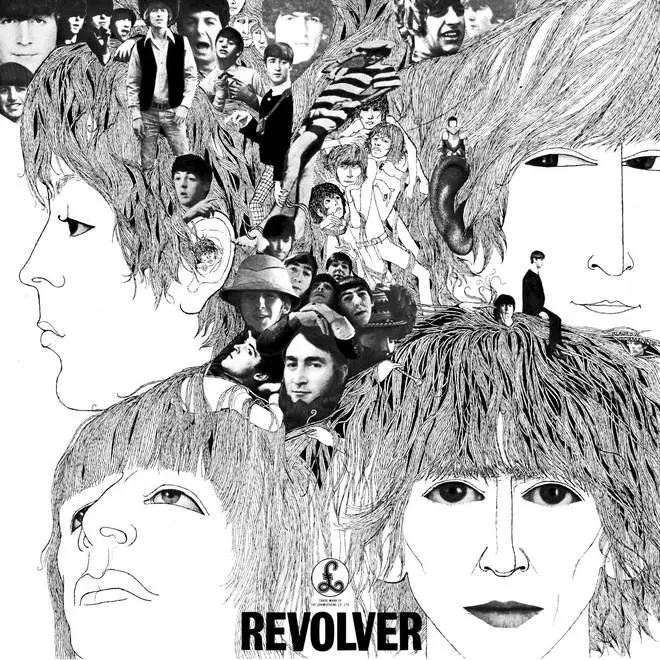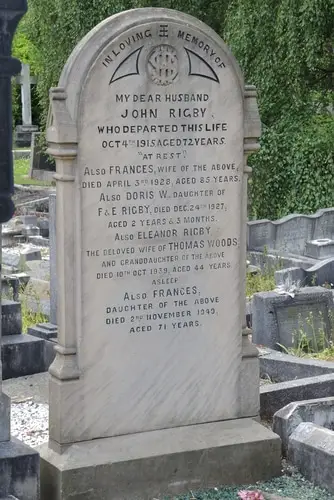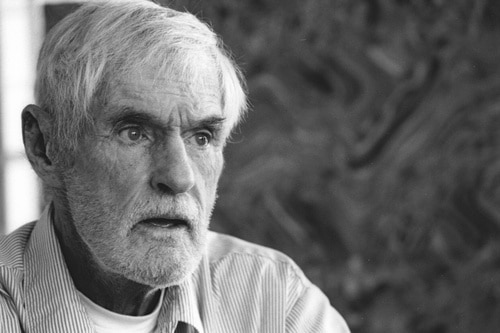[mwai_chatbot_v2 id="default"]
Did you know that The Beatles’ album Revolver was almost entirely different? In fact, only two of the originally planned songs made it onto the final version of the album. The rest were either scrapped or replaced with new tracks. Here are some other fascinating facts about Revolver that you might not know…
1. The album cover was designed by long-time friend of the band (and fellow musician) Klaus Voormann

The Beatles’ Revolver album is an iconic classic of 1960s British music. But while its tracks have earned plenty of accolades over the years, the album’s cover art has also received a fair amount of attention.
Designed by long-time friend of the band and illustrator Klaus Voormann, Revolver’s sleeve featured a groundbreaking montage style, with photos of The Beatles superimposed and others against a pencil drawing background, devoid of colour.
This short video below features Klaus talking about his involvement in the creation.
Despite all this praise, however, it was Voormann’s design that set the tone and served as a major landmark in both youth culture and arts history alike.
Today, more than 53 years later, his work continues to serve as a reminder of The Beatles enduring ingenuity – not just musically but aesthetically as well. Thus Klaus Voormann will forever be remembered as one of Revolver’s many magicians.
2. George Harrison wrote the song “Taxman” in response to the high taxes he was paying at the time
One of the most beloved songs in the Beatles catalogue is “Taxman,” written by lead guitarist George Harrison. Written as a response to the high amount of taxes being paid to the British government at the time, it was well-known that Harrison very much resented having to hand over such a large portion of his income.
Although he remained loyal to his homeland, there was no denying the level of frustration and anger he was feeling watching his hard-earned money go toward taxes.
He decided to channel these emotions into a song, and thus “Taxman” was born. With its biting satire and socially conscious lyrics, such as “But I’m working for no one but me”, it quickly became one of the band’s most iconic hits.
It remains today as an inspiring reminder that even in moments of despair and inequity, art can still be created out of protest against oppressive systems.
In this way, George Harrison ultimately showed us that our voices can be heard without having to resort to violence or aggression — a powerful message for not just musicians but for people everywhere. In doing so, he taught us all something about using creativity to fight injustice and make meaningful change in our world today.
So next time you hear “Taxman” come on, take a moment and appreciate what it has meant through all these years! No matter how much progress we make or how difficult times may become, this timeless tune is sure to offer comfort while reminding us all that we are never alone. That’s something we can always remember even amidst these trying times! Thank you Mr Harrison!
3. Paul played the guitar solo on Taxman
When it comes to The Beatles’ iconic songs, one of the most memorable has to be “Taxman,” George Harrison’s widely acclaimed ode to taxation.
What many don’t know is that while the song was written by Harrison, the guitar solo was actually played by Paul McCartney. Having been a fan of jazz music, McCartney was well-versed in the genre and was able to perfectly add a jazzy edge to the song.
McCartney’s solo is unique for its ability to seamlessly blend blues, rock, reggae, funk and jazz into one powerful track. Its lasting influence can be heard in tracks from artists such as Eric Clapton and Chuck Berry.
By providing such a masterful solo, McCartney was able to turn the already iconic “Taxman” into an even more captivating classic that music fans are still talking about today. Through his contributions to this timeless tune, McCartney made it clear that his creativity was far from over and that he would continue to make waves in the music industry for years to come.
In a way, this moment marked an important milestone in McCartney’s career and cemented his place as one of the greatest musicians of all time. So be sure to give props next time you hear “Taxman” – it wouldn’t have been quite the same without Paul!
4. Many of the songs on Revolver were influenced by drugs, particularly LSD
As the Beatles embarked on their journey to the peak of their craft in their 1966 seminal album, Revolver, it was a bold and innovative departure from the pop songs of their early years.
This revolutionary record was partially shaped in part by drugs – particularly LSD. Songs like “Eleanor Rigby” called attention to loneliness and alienation, while “She Said She Said” laced references to a psychedelic trip that could only be provided by LSD. T
The sitar-tinged sonics of “Love You To” showcased the Indian music style that John Lennon famously became fond of through his experimentation with LSD. In “Doctor Robert,” Lennon directly points his lyrics to a real doctor who prescribed drugs for the band. In addition, during the song “Tomorrow Never Knows” which is infused with drug-influenced audio effects, George Harrison’s guitar solo captures the distorted feeling of being up all night on drugs.
While fans and tourists may come away from Revolver’s visual artistry and genius engineering in awe, its overall soundscape owes some debt to LSD’s unbounded creativity and willingness to go against convention.
As such, drugs remain an important part of understanding Revolver – one that holds up even today decades later as it stands as one of rock music’s greatest albums ever created.
Through these psychotropic experiences and insights, decisions were made on each track within this unmissable masterpiece that has had a generational impact on rock music throughout the ages.
The trailblazing influence left by Revolver will ensure its untouchable presence in any conversation about vintage records forever more.
By many accounts, without the influence of drugs (particularly LSD), Revolver might never have achieved its iconic status or set a standard for albums found today in classic rock playlists around the world.
To this day it remains one of rock music’s greatest albums ever created – a timeless reminder that psychedelia can be extremely influential to any sort of creative work when used correctly and responsibly.
Even after five decades since its release, it continues to live forevermore as an inspiring reminder for future artistic masterminds where musical ingenuity knows no bounds!
5. There was a real Eleanor Rigby

The song “Eleanor Rigby” released in 1966, is one of the most iconic tracks on The Beatles’ Revolver album. It tells a story of loneliness and sadness with its sombre tone and haunting melody. But how did this sad tale come to be?
The answer lies in a real-life figure—a woman named Eleanor Rigby, who was buried in the graveyard of St. Peter’s Church in Woolton, a suburb of Liverpool. While there is no evidence that The Beatles ever met her, it is believed that Paul McCartney first noticed her name on the gravestone when he visited the church with his then-girlfriend Jane Asher in 1963.
There is a strange coincidence between The Beatles classic song “Eleanor Rigby” and an actual Eleanor Rigby. The band originally drafted the name as “Miss Daisy Hawkins”, until Paul McCartney decided it didn’t fit the syllables, so he changed it to the now-popular name.
It’s intriguing that he might have been inspired by actress and comedienne Eleanor Bron, who had recently starred in the movie Help! But even more striking was that there was an Eleanor Rigby already living in Liverpool!
Fortunately for us, she passed away in 1939 – otherwise, she would have been suing for copyright infringement. Truly a funny twist of fate for one of the most important songs in Beatle history.
6. “Got To Get You Into My Life” is about drugs
The Beatles’ 1966 single, “Got To Get You Into My Life,” has long been speculated to hold a deeper meaning behind its cheery lyrics. The song is seen by many as a celebration of drugs – particularly marijuana and LSD – and their role in John Lennon and Paul McCartney’s musical collaboration.
The phrase “Gotta get you into my life,” is interpreted as a metaphor for drug use. This idea is further supported by the line “I was alone and I needed you,” which is seen to refer to the feeling of being on drugs; it’s as if they need the drug in order to feel complete.
In the book Many Years From Now, Paul eventually said: “I’d been a rather straight working-class lad but when we started to get into pot it seemed to me to be quite uplifting. Got To Get You Into My Life is really a song about that, it’s not to a person, it’s actually about pot. It’s saying, I’m going to do this. This is not a bad idea.”
7. Tomorrow Never Knows is taken from the Tibetan Book of The Dead
The Beatles’ classic psychedelic track, “Tomorrow Never Knows,” was released in 1966 on their album Revolver. The song is widely seen as a masterpiece of the psychedelic era and its message remains relevant today this one is about drugs too, specifically LSD.
The title phrase, “Tomorrow Never Knows” comes from Timothy Leary’s book the Tibetan Book Of The Dead. Leary advised readers to “turn on, tune in and drop out” – meaning that they should become liberated from the bonds of society and explore their inner selves through drug use.

The lyric “climb on a steamship that’s moving too fast” is seen as a metaphor for the experience of tripping on drugs, while “listen to the colour of your dreams” is interpreted as an invitation to explore one’s subconscious through psychedelia.
The song further encourages listeners to find strength in their spiritual transformation and understand the concept that tomorrow never knows what will be in store for them. It is a reminder for people to be present in the moment and take risks, even if they are unsure of the outcome. The message is as relevant today as it was in 1966.
Leary was an advocate of LSD and his book The Psychedelic Experience was an attempt to guide acid heads through their use of the often-unpredictable drug. Lennon recorded himself reading the instructions onto tape and played it back as began his trip.
Leary’s guide on how to use LSD was the most popular book of its time. The Psychedelic Experience outlined his theory that people should take these drugs in order for them to have meaningful experiences with life and appreciate what they have while also being aware there are many alternatives available like coffee or tea which can give you something similar but not nearly as intense so those who want more out their day-to protect your brain from Alzheimer’s disease
In 1970, Leary wrote, “The Scope” which discussed this idea further by suggesting different methods such as meditation and mollycoddling (a type of unconventional therapy)are ways one might pursue personal growth.
8. The character “Doctor Robert” was likely a real person
The lyrics talk about a mysterious doctor who can provide a variety of services, such as providing drugs or offering assistance with personal problems. Many believe the song is referencing Dr. Robert Freymann, a real-life doctor who practised in New York City and famously prescribed a variety of drugs to his patients. He was known to be a go-to figure for Beatles fans looking to find LSD. Whether or not this is the same person that The Beatles are referencing remains unclear.
Regardless, Dr. Robert has become linked to the Beatles legend and their history with psychedelic drug use. The song serves as both a warning of the dangers that come with drug experimentation, but also as an invitation to explore one’s inner self through psychedelia. It is a reminder for people to be mindful of the risks associated with drugs, but to not be afraid to take calculated chances in life.
In 1987, he passed away after losing his license in 1975. He left behind a book called “What’s So Bad About Feeling Good?”
9. Apart from Paperback Writer, The Beatles never play any of these songs from the Revolver album live
The Beatles never performed any songs from the Revolver album in concert. This is because they become disillusioned playing the same songs to crowds of screaming fans that couldn’t even hear what they were playing. Combining this with the complexity of some of the tracks on Revolver made them difficult to translate live.
Furthermore, The Beatles stopped touring in 1966 and much of their later material wasn’t suitable for a live setting, making it impossible for them to perform any of the Revolver songs live. The Beatles instead focused on perfecting their studio recordings and pushing boundaries in terms of production and songwriting, rather than being limited to performing live. As a result, the Revolver album remains one of the most iconic albums in music history, a testament to The Beatles’ creative genius.
10. The UK and US versions of the Revolver album are different
The UK and US versions of the Revolver album were different because they were produced in different countries. The UK version was prepared in London while the US version was prepared in Los Angeles. Additionally, the track listings were slightly different as well as some of the artwork.
The US version also included two tracks that were not on the UK version: “I’m Only Sleeping”, which was previously released as a single in the UK, and an instrumental version of “Tomorrow Never Knows”. Both versions contained tracks that were not available on either release – such as “Taxman” and “And Your Bird Can Sing” – but only appeared on later compilations.
The differences between the two releases indicate that The Beatles were keen to appeal to different markets, and their willingness to experiment with multiple versions of a record shows how forward-thinking they were in terms of production. This is one of the many reasons why Revolver remains an influential album today.
It was also released at a time when UK and US music culture was fairly distinct, which meant that the two versions of the Revolver album could be tailored to different audiences. This allowed them to reach a much wider audience and further cement their place in musical history.
11. Tomorrow Never Knows is one of the many innovative techniques used on The Beatles’ Revolver album & beyond
The high-pitched bird-like sound on the song “Tomorrow Never Knows” is actually an effect called a ‘reverse echo,’ which was created by engineer Geoff Emerick. The effect was achieved by feeding John Lennon’s vocal track through a rotating Leslie speaker and recording it onto an additional tape reel in reverse.
The result was a sound that echoed backwards, creating a unique sonic texture. This effect became an integral part of “Tomorrow Never Knows” and is one of the many innovative techniques used on The Beatles’ Revolver album. It stands out to this day as a defining moment in popular music production and has been used by countless other artists.
12. There is a simple and also complex multiple explanations as to why the album was called Revolver
When the classic album Revolver was first released, it caused quite a stir among Beatles fans who were eager for something new. Little did they know that the name was actually a desperate attempt at clever wordplay!
The title is a clever nod to the speed of an LP as it revolves on the turntable – 33-and-a-third revolutions per minute. But before settling on that relatively witty title, band members threw around names like “Beatles On Safari” and even “Abracadabra”. Thankfully, keen taste prevailed and we ended up with the magnificent album that is known lovingly simply as Revolver!
But the decision to call the album Revolver goes beyond the inspiration for the name itself.
The album is called Revolver because it marks a turning point in the Beatles’ career. The band had been experimenting with different sounds and instruments, which was reflected both in their songwriting and production techniques. They were determined to push the boundaries of popular music by creating a record that was unlike anything else at the time.
The name ‘Revolver’ could be seen as a metaphor for their new sound, which was constantly changing and evolving. It was also meant to represent the group’s desire to move forward and continue innovating.
The artwork of the album is also significant: it features a collage of photographs depicting The Beatles in different poses as if they are in a fast-moving carousel. This further reinforces the idea of movement and evolution, which is symbolized by the title.
Finally, it has been suggested that Revolver was chosen as a homage to the band’s early influences. In particular, it pays tribute to Bob Dylan’s 1965 album Bringing It All Back Home, which was also titled Revolver.
All in all, Revolver is an iconic album that marked a major turning point in The Beatles’ career and established them as one of the most influential bands of all time. Its title perfectly encapsulates their forward-thinking sound and pioneering production techniques.
13. McCartney wrote “Here, There and Everywhere” while waiting for Lennon to get out of bed.
The Beatles’ Revolver album contains many classic songs, one of the most memorable being “Here, There and Everywhere”. The track is a beautiful love song written by Paul McCartney and was released as the B-side to “Yellow Submarine”.
The story behind this timeless track is quite interesting. It is said that McCartney wrote the song while waiting for John Lennon to get out of bed. He was inspired by the beautiful landscape outside of his home studio and wanted to capture some of its beauty in a song.
The song itself is an example of McCartney’s genius, as it manages to convey a deep sentimentality despite
It’s a relatively simple structure. The lyrics, specifically the line “Here, making each day of the year/Changing my life with a wave of her hand”, are particularly touching and show McCartney’s ability to express emotion through music.
The song was played on an acoustic guitar by McCartney himself during recording sessions for Revolver.
“I sat out by the pool on one of the sun chairs with my guitar,” McCartney says in Barry Miles’ Many Years From Now. Not long after, he produced “Here, There and Everywhere,” which came to be one of Lennon’s favourite Beatles songs.
“John might have helped with a few last words,” McCartney continues. “When I sang it in the studio I remember thinking, I’ll sing it like Marianne Faithfull; something no one would ever know.”
14. “She Said She Said” was originally “He Said He Said.”
One of the most memorable tracks from The Beatles’ Revolver album is “She Said She Said”, a song written by John Lennon. What many people don’t know is that the song was actually originally called “He Said He Said”!
The story behind this title change comes from an event that happened in 1965. Lennon and the other Beatles were on a plane heading to California when they encountered actor Peter Fonda, who was tripping on acid at the time.
During their conversation, Fonda kept repeating “He said he said” until it eventually made its way into Lennon’s subconscious. Later, when Lennon was writing the song, he realized that Fonda’s phrase was the perfect title for it.
Interestingly, when Lennon wrote the lyrics to “She Said She Said” he changed the gender of the people involved in order to make it more universal and relatable. This simple change resulted in one of The Beatles’ most memorable songs.
Revolver was a turning point for The Beatles with its groundbreaking sound and production techniques, classic songs, and iconic artwork. While it has been more than 50 years since its release, the album still continues to influence many artists today, all of whom owe a debt of gratitude to this timeless masterpiece.
Fonda was later quoted saying, “It was a thoroughly-tripped out atmosphere because they kept finding girls hiding under tables and so forth: one snuck into the poolroom through a window while an acid-fired Ringo was shooting pool with the wrong end of the cue.”
15. Father McKenzie from “Eleanor Rigby” could have been Father McCartney
The Beatles’ Revolver album also contains one of their most iconic songs, “Eleanor Rigby”. The track is known for its unique structure, which tells the story of a lonely woman with no family or friends. However, few people know that the song was originally intended to feature Paul McCartney’s father as the main character.
McCartney’s father, Jim McCartney, was a member of the Salvation Army and McCartney wanted to honor him by writing a song about his life and struggles. The original title for the track was “Father McKenzie” in recognition of his father’s profession.
Even though the idea was eventually abandoned, McCartney was still able to incorporate aspects of his father into the song. The line “All the lonely people/Where do they all come from?” is a reference to Jim McCartney’s work with the Salvation Army and his efforts to help the less fortunate.
it was John’s friend, Pete Shotton, who was visiting them at the time pointed out how the song may be misinterpreted.
The song’s original title was “Father McCartney,” but when Shotton heard that people might think it was about his poor old dad left all alone in Liverpool he promptly interjected with a fair point that people would think this referenced Paul’s father left all alone in Liverpool to darn his own socks.
Everyone chuckled at the thought, but it did bring about an important conversation for a better-suited name for Father McCartney. After several ludicrous suggestions, each one funnier than the next, Shotton used his brilliance once again and came up with Father McKenzie and of course the idea to have him officiate the burial service for Ms. Rigby. It seems as if this light conversation was just what this legendary song needed for its story and foundation.
16. The count-in for “Taxman” was recorded a month after the song itself
There are some unbelievable tales to come out of the often strange-sounding sessions that created the Revolver album. Perhaps none more strange than what went into Harrison’s “Taxman”.
After recording four takes on April 20th, they had yet to have figured out how to start the track. Enter George Harrison with his mischievous wit, who provided his own suggestion: “One, two, three, four” – a classic count-in!
What makes this so peculiar is that it was actually Paul McCartney who provided the count-in at the re-recording in May, lending his not-so-smooth vocals to bring life to one of The Beatles’ most iconic songs.
17. The album’s distinctive drum sound was created using a jumper
Who said fashion couldn’t be used to make music? The iconic album Revolver features the unmistakable drum sounds of Ringo Starr, who had a little help to achieve his unique compositional approach.
All owed in part to a clever idea from engineer Emerick, who decided to harness the power of woollen fashion – in the form of an ostentatious and conspicuous four-necked sweater – to muffle the noise of the drums.
Talk about getting creative in recording studios! With some manipulation through Fairchild 600 valve limiters and compressors, Emerick was able to create that distinctive Beatles sound that has defined generations. Who needs drum skins when you can use a cozy jumper instead?
